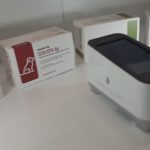Abstract
Hybridomas were produced that secrete monoclonal antibodies (MAbs) specific for all members of the genus Leptospira (clone LF9) and those that are specific only for the pathogenic species (clones LD5 and LE1). MAb LF9, which was immunoglobulin G1 (IgG1), reacted with a 38 kDa component of whole-cell lysates separated by sodium dodecyl sulfate-polyacrylamide gel electrophoresis of all Leptospira species, while MAb LD5 and MAb LE1, which were IgG1 and IgG2a, respectively, reacted to the 35 to 36 kDa components of all serogroups of pathogenic Leptospira species.
MAb LD5 was used in an enzyme-linked immunosorbent assay (dot-ELISA) to detect Leptospira antigen in urine samples collected serially from two groups of patients diagnosed with leptospirosis, i.e. 36 clinically diagnosed and 25 confirmed patients. by the cultivation of Leptospira. . Their serum samples were serologically analyzed using the IgM dipstick test, the indirect immunofluorescence test (IFA) and/or the microscopic agglutination test (MAT). Urine samples from 26 patients diagnosed with other diseases and 120 healthy individuals served as controls.
For the first group of patients, who had been ill for an average of 3.4 days before hospitalization, the IgM Dipstick, IFA and MAT test were positive for 69.4, 70.0 and 85.7% of the patients, while the Leptospira antigenuria tested by the MAb The dot-ELISA based on points was positive for 75.0, 88.9, 97.2, 97.2 and 100% of the patients on days 1, 2, 3, 7 and 14 of hospitalization, respectively. All but 1 of 11 patients whose serum samples collected on the first day of hospitalization were seronegative for IgM, tested positive for antigen in urine on day 1. This is strong evidence that detection of antigen in urine can provide diagnostic information that could be useful in directing early therapeutic intervention.
MAT was positive in 10 of 12 patients (83.3%) of the 25 culture-positive Leptospira patients who had been ill for an average of 5.04 days prior to hospitalization, and Leptospira antigen was found in 64, 0, 84.0, 96.0, 100, 100, 100, and 100% of urine samples from patients collected on days 1, 2, 3, 4, 5, 6, and 7 of hospitalization, respectively. Leptospira antigenuria was found in 3 of the 26 patients diagnosed with other diseases and in 1 of the 120 healthy controls. The reasons for this positivity are discussed. Urine antigen detection by monoclonal antibody-based dot-ELISA has a high potential for rapid, sensitive and specific diagnosis of leptospirosis at low cost.
Preferred minimum: 1 mL of serum in a red-top tube
Absolute minimum: 0.2 ml of serum in a red-top tube
Rejection criteria:
Severely lipemic, hemolyzed, heat-inactivated, or contaminated samples. Any other bodily fluid.
Lap time:
1-5 days from receipt in the reference laboratory.
Reference range:
- Negative: No significant level of IgM antibodies to Leptospira was detected.
- Doubtful: Questionable presence of detected Leptospira IgM antibodies. It may be helpful to repeat the test in 10 to 14 days.
- Positive: the presence of detected IgM antibodies to Leptospira, suggesting a current or recent infection.
Interpretive Data:
Samples interpreted as negative indicate that the antibody is not present in the sample or is below the detection level of the method. Since antibodies may not be present during the early stages of the disease, confirmation two to three weeks later is recommended. An initially negative result followed by a positive result indicates IgM seroconversion.
Misleading samples should be interpreted with caution. Further testing with an additional sample is recommended. If the sample remains equivocal, a second serologic method should be considered if leptospirosis infection is still suspected.
Samples interpreted as positive may indicate the specific antibody. However, the presence of antibodies alone cannot be used for the diagnosis of an acute infection, as antibodies from previous exposure can circulate for a prolonged period of time.
Note: A negative result does not rule out the possibility of leptospirosis.
Methodology: Qualitative immunoblot
CPT code: 86720
Results
A total of 3.9 × 10 8 spleen cells were obtained from a selected immunized mouse having an indirect ELISA titer of antibody against a homologous antigen of 1: 12,800; cells were mixed with 3.6×107 myeloma cells in the cell fusion procedure. The 790-well culture fluids that revealed growing cells were tested for antibodies against the homologous antigen, ie, sonication of L. interrogans serovar icterohaemorrhagiae and the 48-well fluids (4.7%) were positive. The positive culture fluids were then subjected to WB analysis against the homologous antigen separated by SDS-PAGE.
Cells from wells having culture fluids showing different patterns in WB analysis against homologous antigen were selected for further cloning by the limiting dilution method, and 41 monoclines (hybridomas) were obtained. The culture fluids of these hybridomas were tested against the heterologous antigens listed in Table 11 by indirect ELISA and dot-ELISA and only three clones showed specificity for antigens prepared from Leptospira organisms. These three clones were designated 15C4G11, 13E2B9, and 2D9G8. They were then recloned by limiting dilution to ensure the monoclonality of all clones.
Finally, four hybridoma clones (i.e. clones LB4, LD5, LD6, and LD8) were obtained from parental clone 15C4G11, and one clone from each (i.e. clones LF9 and LE1) was derived from parental clones 13E2B9 and 2D9G8, respectively. The MAb isotypes were IgG1 for clones LB4, LD5, LD6, LD8 and LF9 and IgG2a for clone LE1. The antibody titers were presented in the spent culture media when the monoclines had grown to stationary phase. The antibody titers were constant; various subcultures of these clones always produced the same titers.
